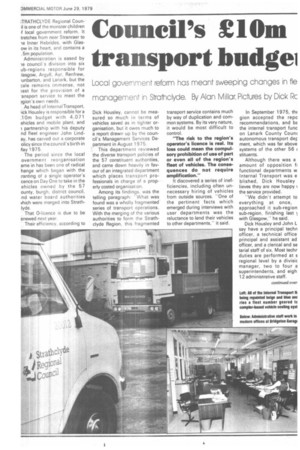ouncirs Elm Om transport budge
Page 47

If you've noticed an error in this article please click here to report it so we can fix it.
Local government reform has meant sweeping changes in tie management in Stra clyde. By Alan Millar. Pictures by Dick Rc
iTRATHCLYDE Regional Counil is one of the monster children local government reform. It tretches from near Stranraer to ie Inner Hebrides, with Glasow in its heart, and contains a .5m population.
Administration is eased by le council's division into six ub-regions responsible for ilasgow, Argyll, Ayr, Renfrew, iunbarton, and Lanark, but the cale remains immense, not .ast for the provision of a iansport service to meet the gion's own needs.
As head of Internal Transport, lick Housley is responsible for a :10m budget with 4,071 ehicles and mobile plant, and 1 partnership with his deputy nd fleet engineer John Linday, has carved out a corporate .olicy since the council's birth in 4ay 1975.
The period since the local overnment reorganisation ame in has been one of radical hange which began with the Iranting of a single operator's cence on Day One to take in the ehicles owned by the 57 ounty, burgh, district council, :nd water board authorities vhich were merged into Strath:lyde.
That 0-licence is due to be enewed next year.
Their efficiency, according to
Dick Housley, cannot be measured so much in terms of vehicles saved as in tighter organisation, but it owes much to a report drawn up by the council's Management Services Department in August 1975.
This department reviewed the diverse transport policies of the 57 constituent authorities, and came down heavily in favour of an integrated department which places transport professionals in charge of a properly costed organisaton.
Among its findings, was the telling paragraph: "What was found was a wholly fragmented' series of transport operations. With the merging of the various authorities to form the Strathclyde Region, this fragmented transport service contains much by way of duplication and common systems. By its very nature, it would be most difficult to control.
"The risk to the region's operator's licence is real. Its loss could mean the compulsory prohibition of use of part or even all of the region's fleet of vehicles. The consequences do not require amplification."
It discovered a series of inefficiencies, including often unnecessary hiring of vehicles from outside sources. "One of the pertinent facts which emerged during interviews with user departments was the reluctance to lend their vehicles to other departments," it said. In September 1975, thE gion accepted the repc recommendations, and biz the internal transport func on Lanark County Couni autonomous transport der ment, which was far above systems of the other 56 stituents.
Although there was a amount of opposition if: functional departments w Internal Transport was e blished, Dick Housley lieves they are now happy the service provided.
"We didn't attempt to everything at once, approached it sub-region sub-region, finishing last N, with Glasgow," he said.
Dick Housley and John L say have a principal techn officer, a technical office principal and assistant ad officer, and a clerical and se tarial staff of six. Most techr duties are performed at s regional level by a divisic manager, two to four a superintendents, and eigh 12 administrative staff.
































































































































